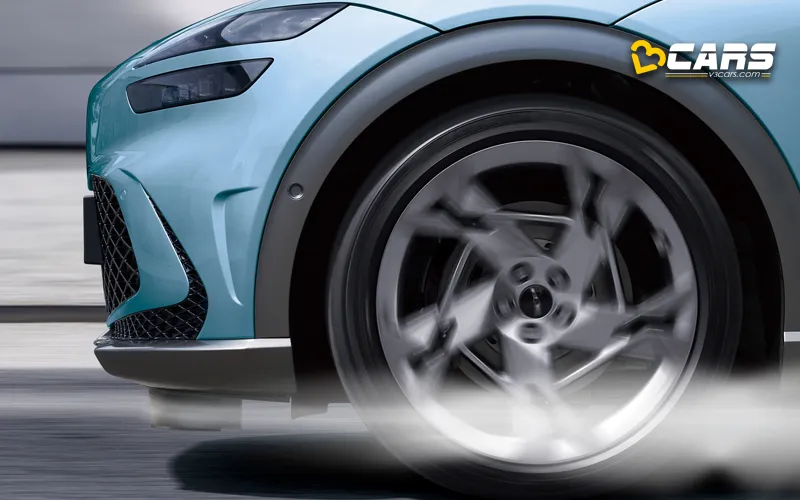Hyundai and Kia Introduce 'Active Air Skirt' Technology for Enhanced EV Aerodynamics and Range (Press Release) | V3Cars
Hyundai and Kia have introduced the 'Active Air Skirt' (AAS) technology to enhance aerodynamics in electric vehicles (EVs). AAS controls air flow around the front wheels, reducing turbulence during high-speed driving. It deploys above 80 km/h and retracts at 70 km/h, aiming to optimize aerodynamic performance without constant operation. The design, specific to Hyundai's E-GMP platform, covers only the front tires, improving downforce, traction, and high-speed stability.

AAS has been tested on the Genesis GV60, reducing the drag coefficient by 0.008 (2.8% improvement), potentially extending the range by 6 km. The technology can operate at speeds exceeding 200 km/h, utilizing rubber material for durability. Hyundai and Kia plan mass production after durability and performance testing, emphasizing its significance for SUVs. The companies employ various aerodynamic technologies across their models, with the Hyundai IONIQ 6 achieving a global leading drag coefficient of 0.21, incorporating features like rear spoilers and wheel air curtains.
Also Read: Maruti Suzuki Car Offers, January 2024; Baleno, Dzire, Swift, Vitara
Honda Car Offers For January 2024; Amaze, City Discount Offers
Note: If You Want to Buy a New Car, Calculate Car Loan EMI with V3Cars

Here’s what Hyundai have to say about the launch of ‘Active Air Skirt’:
Hyundai Motor Company and Kia Corporation today unveiled the ‘Active Air Skirt’ (AAS) technology that minimizes the aerodynamic resistance generated during high-speed driving, effectively improving the driving range and driving stability of electric vehicles (EVs).
AAS is a technology that controls the flow of air entering through the lower part of the bumper and effectively controls the turbulence generated around the vehicle wheels by operating variably according to the vehicle speed during high-speed driving.
In the EV era, competition to secure a better driving range from a single charge has become fierce, making the relationship between vehicles and aerodynamics even more important. Furthermore, aerodynamic performance has a significant impact not only on power performance but also on driving stability and wind noise.
In response, manufacturers are exploring various measures to reduce the coefficient of drag (Cd), which is the resistance coefficient of the air acting in the opposite direction of the vehicle’s motion.
AAS is installed between the front bumper and the front wheels of the vehicle and is hidden during normal operation, but it operates at speeds over 80 km/h when the aerodynamic resistance becomes greater than the rolling resistance and is stored again at 70 km/h. The reason for the difference in deployment and storage speeds is to prevent frequent operation in specific speed ranges.
Also, the reason why AAS only covers the front part of the tires without completely covering the front is related to the characteristics of Hyundai Motor Group’s E-GMP platform for EVs. This is because it is more effective in improving aerodynamic performance to only cover the tire part since the platform floor is flat. This also functions to enhance downforce of the vehicle, thereby improving vehicle traction and high-speed stability.
AAS can also operate at speeds over 200 km/h. This was possible thanks to the application of rubber material on the lower part, which reduces the risk of external objects splashing and damaging while driving at high speeds and ensures durability.
Hyundai Motor and Kia announced that they have tested and reduced the drag coefficient (Cd) by 0.008, improving drag by 2.8 percent, by installing AAS in Genesis GV60. This is a figure that can expect an additional range improvement of about 6 km.
Hyundai Motor and Kia have applied for related patents in South Korea and the United States, and plan to consider mass production after durability and performance tests.
“This technology is expected to have a greater effect on models such as SUVs where it is difficult to improve aerodynamic performance,” said Sun Hyung Cho, Vice President and Head of Mobility Body Development Group at Hyundai Motor Group. “We will continue to strive to improve the driving performance and stability of electric vehicles through improvements in aerodynamics.”
Meanwhile, Hyundai Motor and Kia are applying various technologies, such as rear spoilers, active air flaps, wheel air curtains, wheel gap reducers and separation traps, to vehicles to secure competitive drag coefficients. Hyundai IONIQ 6, which incorporates these technologies, has achieved a global leading Cd of 0.21.
Also Read: Hyundai Car Offers For January 2024; i20, Nios, Aura, Venue, Venue
Renault Car Offers For January 2024; Kwid, Kiger, Triber Discount Offers
Note: Calculate Car Fuel Cost with V3Cars for India and Other Countries



0 Comments
Hyundai Cars in India
Venue
₹7.94 - ₹13.53 lakh*
*Ex-showroom pricei20 N
Line
₹10.00 - ₹12.56 lakh*
*Ex-showroom pricei20
₹7.79 - ₹11.25 lakh*
*Ex-showroom priceCreta EV
₹17.99 - ₹23.50 lakh*
*Ex-showroom priceAlcazar
₹14.99 - ₹21.55 lakh*
*Ex-showroom priceCreta N
Line
₹16.93 - ₹20.56 lakh*
*Ex-showroom priceCreta
₹11.11 - ₹20.27 lakh*
*Ex-showroom priceExter
₹6.00 - ₹10.50 lakh*
*Ex-showroom priceVerna
₹11.07 - ₹17.55 lakh*
*Ex-showroom priceAura
₹6.54 - ₹9.11 lakh*
*Ex-showroom priceGrand i10
Nios
₹5.98 - ₹8.62 lakh*
*Ex-showroom priceIoniq 5
₹46.05 lakh*
*Ex-showroom priceVenue N
Line
₹12.15 - ₹13.97 lakh*
*Ex-showroom priceTucson
₹0.36 - ₹35.89 lakh*
*Ex-showroom priceVenue
₹7.94 - ₹13.53 lakh*
*Ex-showroom pricei20 N
Line
₹10.00 - ₹12.56 lakh*
*Ex-showroom pricei20
₹7.79 - ₹11.25 lakh*
*Ex-showroom priceCreta EV
₹17.99 - ₹23.50 lakh*
*Ex-showroom priceAlcazar
₹14.99 - ₹21.55 lakh*
*Ex-showroom priceCreta N
Line
₹16.93 - ₹20.56 lakh*
*Ex-showroom priceUpcoming Hyundai Cars
Sonata Facelift
₹30.00 - ₹35.00 lakh*
*Expected PriceExpected Launch Dec 2027
Nexo
₹40.00 - ₹50.00 lakh*
*Expected PriceExpected Launch Jan 2030
Staria
₹45.00 - ₹55.00 lakh*
*Expected PriceExpected Launch Jan 2030
Venue CNG
₹8.50 - ₹10.00 lakh*
*Expected PriceExpected Launch Jan 2025
Kona EV
Facelift
₹24.00 - ₹26.00 lakh*
*Expected PriceExpected Launch Feb 2025
Creta CNG
₹10.50 - ₹18.74 lakh*
*Expected PriceExpected Launch Jul 2025
Verna N
Line
₹15.00 - ₹17.00 lakh*
*Expected PriceExpected Launch Aug 2025
Ioniq 6
₹65.00 - ₹80.00 lakh*
*Expected PriceExpected Launch Aug 2025
Grand i10
Nios N Line
₹5.85 - ₹8.75 lakh*
*Expected PriceExpected Launch Sep 2025
Ioniq 9
₹80.00 - ₹90.00 lakh*
*Expected PriceExpected Launch Jan 2026
Ioniq 5
N
₹80.00 lakh*
*Expected PriceExpected Launch Jan 2026
Palisade
₹40.00 - ₹45.00 lakh*
*Expected PriceExpected Launch Jan 2026
Santa FE
₹25.00 - ₹28.00 lakh*
*Expected PriceExpected Launch Apr 2026
Stargazer
₹11.00 - ₹18.00 lakh*
*Expected PriceExpected Launch Jun 2026
Next Gen
Elantra
₹18.00 - ₹22.00 lakh*
*Expected PriceExpected Launch Dec 2027
Sonata Facelift
₹30.00 - ₹35.00 lakh*
*Expected PriceExpected Launch Dec 2027
Nexo
₹40.00 - ₹50.00 lakh*
*Expected PriceExpected Launch Jan 2030
Staria
₹45.00 - ₹55.00 lakh*
*Expected PriceExpected Launch Jan 2030
Venue CNG
₹8.50 - ₹10.00 lakh*
*Expected PriceExpected Launch Jan 2025
Kona EV
Facelift
₹24.00 - ₹26.00 lakh*
*Expected PriceExpected Launch Feb 2025
Creta CNG
₹10.50 - ₹18.74 lakh*
*Expected PriceExpected Launch Jul 2025
Latest Hyundai Cars Videos
Hyundai IONIQ 5 LED Headlamps & Parking Camera Review At Night | The Sensible Review | June 2024
Hyundai Creta Turbo DCT Mileage Test using Tank-to-tank Method w/ Drive Impressions | Apr 2024
Hyundai Creta LED Headlamps & Parking Camera Review At Night | The Sensible Review | April 2024
Hyundai Creta EV Variants Explained | Executive, Smart, Smart (O), Premium, Excellence
Hyundai Creta Electric First Drive Review | Range, Charging Time, Ground Clearance & All Details
Hyundai Exter vs Maruti Fronx: Sub Rs 8.5 Lakh Battle | Which Car Is More Value for Money?
2024 Hyundai Exter Rear Seat & Boot Space Review | Can 3 People Sit In Rear Of The Exter?
Hyundai Exter vs Tata Punch: Which car is more value for money?
Hyundai Alcazar First Drive Impression | Rear Seat Comfort, Ride, Turbo-petrol DCT Powertrain
2024 Hyundai Alcazar Walkaround Review | Exterior Changes | Interior Space | Full Price List
Hyundai IONIQ 5 LED Headlamps & Parking Camera Review At Night | The Sensible Review | June 2024
Hyundai Creta Turbo DCT Mileage Test using Tank-to-tank Method w/ Drive Impressions | Apr 2024
Hyundai Creta LED Headlamps & Parking Camera Review At Night | The Sensible Review | April 2024
Hyundai Creta EV Variants Explained | Executive, Smart, Smart (O), Premium, Excellence
Hyundai Creta Electric First Drive Review | Range, Charging Time, Ground Clearance & All Details
Hyundai Exter vs Maruti Fronx: Sub Rs 8.5 Lakh Battle | Which Car Is More Value for Money?
Alcazar Important Links